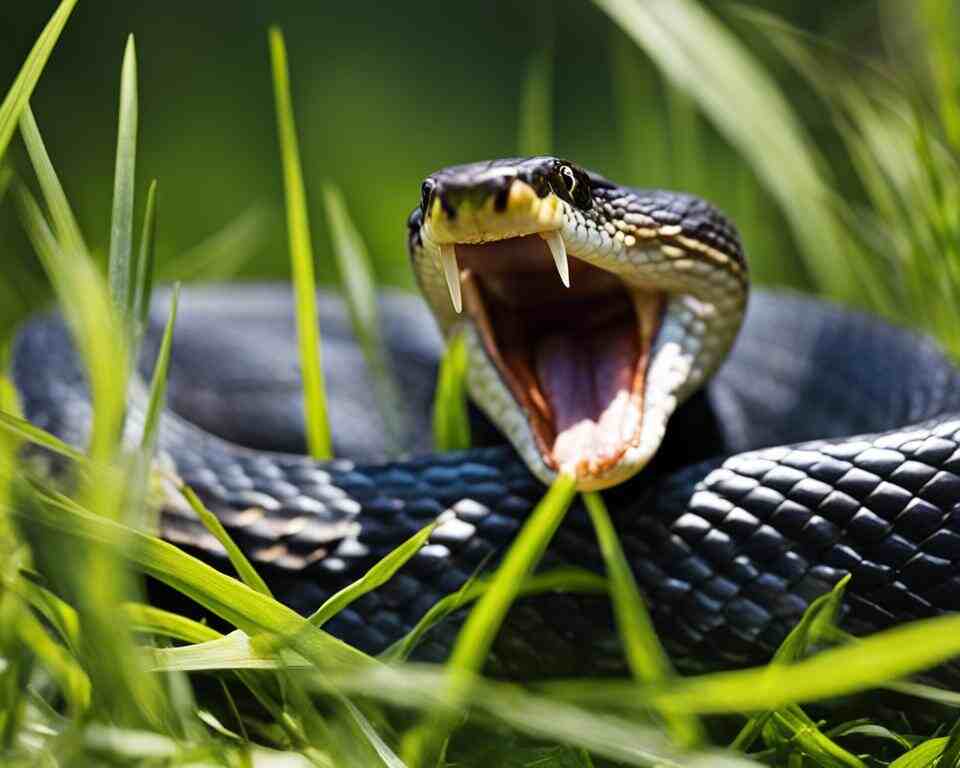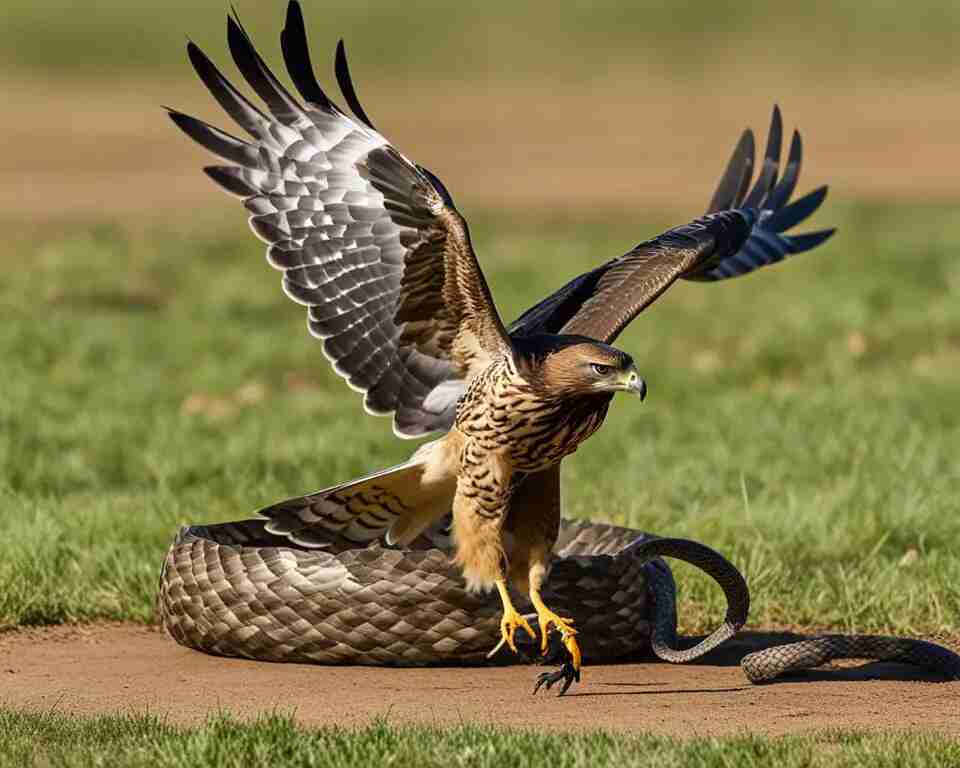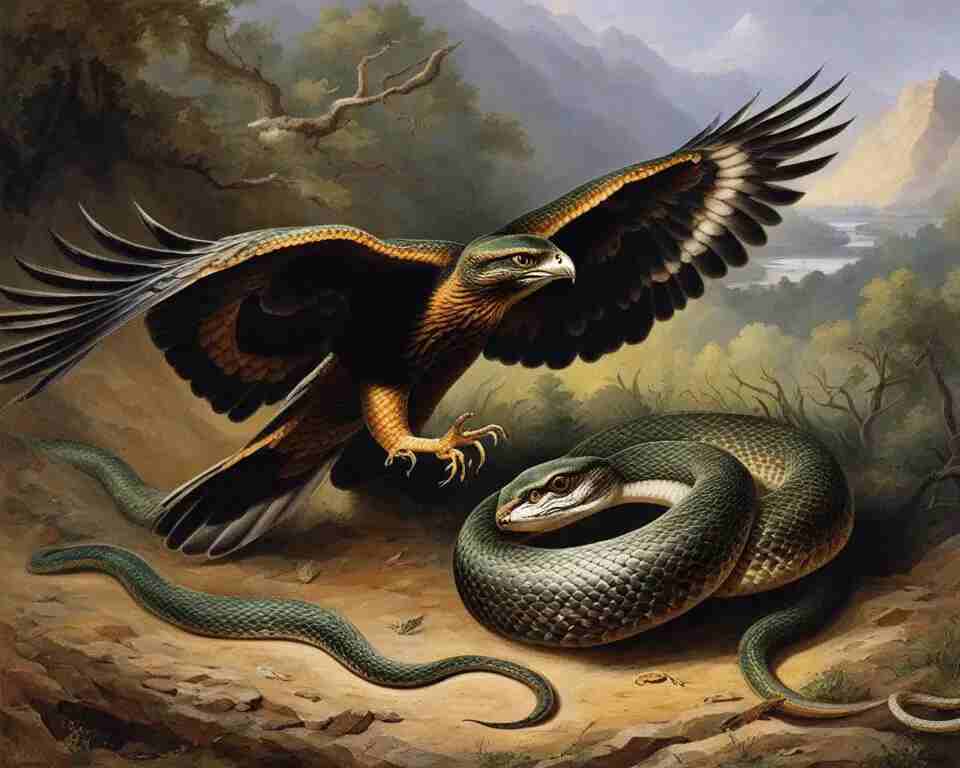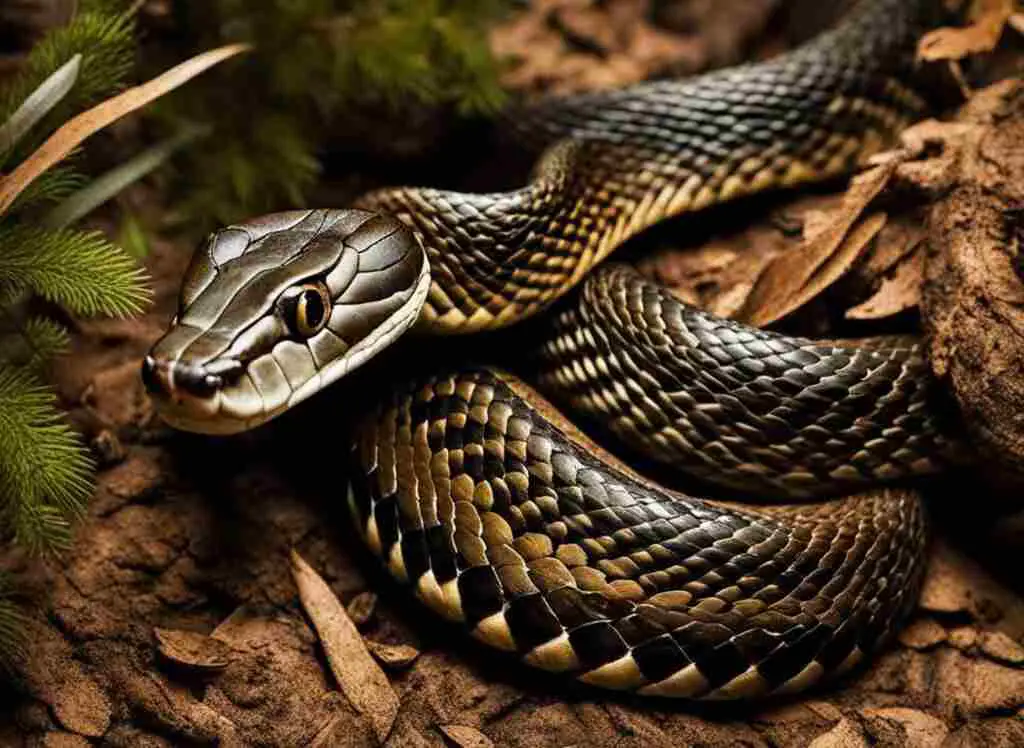When it comes to the intricate web of nature’s food chain, one fascinating question arises: do snakes eat hawks? Snakes, as carnivorous predators, have a wide-ranging diet that includes birds of prey like hawks.
While it is more common for hawks to prey on snakes, the tables can turn, and snakes can also target and consume hawks in specific situations.
Let’s delve into the intriguing interaction between these two creatures and unravel the mysteries of their predator-prey relationship.
Table of Contents
- 1 Key Takeaways
- 2 Snakes as Predators of Hawks in the Wild
- 3 Hawks as Predators of Snakes
- 4 Snake vs Hawk: A Clash of Predators
- 5 A Visual Breakdown of Snake vs Hawk Predation
- 6 Snakes That Consume Hawks
- 7 Hawks as Prey for Snakes
- 8 Snake Feeding Behavior and Predation Patterns on Hawks
- 9 Predatory Interactions Between Hawks and Snakes
- 10 Conclusion
- 11 FAQs:
- 11.1 Are hawks predators of snakes?
- 11.2 How do snakes hunt and consume hawks?
- 11.3 How do hawks defend themselves against snakes?
- 11.4 Can both snakes and hawks die during their encounters?
- 11.5 Which species of snakes consume hawks?
- 11.6 Can hawks become prey for snakes?
- 11.7 What is the role of snakes in the food chain?
- 11.8 What is the role of hawks in the food chain?
- 12 Source Links
- 13 Author
Key Takeaways
- Snakes are carnivorous predators and can eat birds of prey like hawks.
- Hawks primarily prey on snakes, but snakes can also consume hawks in certain situations.
- Snake and hawk interactions are complex and can result in both animals becoming food for each other.
- Snakes may inject venom into hawks to weaken them, while hawks use their sharp beaks and talons to kill snakes.
- Some venomous and non-venomous snake species, such as rattlesnakes, corn snakes, and kingsnakes, are known to consume hawks.

Snakes as Predators of Hawks in the Wild
Snakes play an important role in the food chain as predators of hawks and other birds. Their hunting behavior and feeding habits allow them to target and consume hawks in the wild. Different snake species employ various strategies to capture their avian prey.
Rattlesnakes, for example, are ambush predators that strike at approaching birds with lightning speed, injecting venom to incapacitate them. On the other hand, corn snakes, rat snakes, couchwhip and kingsnakes are skilled climbers that raid hawk nests, consuming chicks and eggs.
These predatory interactions between snakes and hawks provide insight into the complex relationship between these two species. While hawks are typically considered the predators, snakes have evolved unique adaptations and feeding behaviors that allow them to target and consume these birds of prey.
These interactions play a vital role in maintaining the balance of predator-prey relationships within ecosystems.
Understanding the dynamics between snakes and hawks in the wild helps us appreciate the diverse strategies employed by both species. While hawks are formidable hunters, snakes possess their own set of skills and tactics to capture and consume these birds.
This intricate dance of predator and prey highlights the fascinating interactions that occur within nature’s food chain.
The Snake-Hawk Relationship in Numbers:
| Snake Species | Hawk Prey |
|---|---|
| Rattlesnakes | Inject venom to incapacitate hawks |
| Corn snakes | Raid hawk nests, consume chicks and eggs |
| Kingsnakes | Raid hawk nests, consume chicks and eggs |
As the table above illustrates, there are several snake species that actively prey on hawks. Each species employs distinctive hunting strategies to capture and consume their avian prey. This highlights the diverse feeding habits and food chain dynamics within the snake-hawk relationship.
Hawks as Predators of Snakes
The relationship between hawks and snakes is not one-sided. While snakes are often portrayed as the hunters, hawks can also be predators of snakes in certain circumstances. Hawks, with their sharp beaks and powerful talons, are well-equipped to capture and kill snakes.
Hawks primarily target smaller to medium-sized snakes that they can easily overpower and carry into the air. They typically avoid larger snakes like adult pythons and anacondas. The hunting behavior of hawks involves swooping down from above, using their speed and agility to catch the snake by surprise.
The hawk’s ability to kill snakes relies on its quick reflexes, strong grip, and precise strikes. Once a hawk has caught its prey, it will use its beak to deliver a lethal blow or suffocate the snake. The hawk’s diet consists of various animals, and snakes, including venomous ones, are among their natural prey.

| Hawk Predation on Snakes | Snake Species |
|---|---|
| Prey Size | Small to medium-sized snakes |
| Predation Techniques | Quick strikes with sharp beaks and talons |
| Prey Avoidance | Avoidance of larger snakes like pythons and anacondas |
| Diet Composition | Includes snakes as part of their natural prey |
Hawk Predation on Snakes: Key Facts
- Hawks can capture and kill smaller to medium-sized snakes.
- Hawks use their sharp beaks and talons to deliver precise strikes.
- They avoid larger snakes like pythons and anacondas.
- Snakes are part of the hawk’s natural diet.
The predator-prey relationship between hawks and snakes adds another layer of complexity to the intricate web of nature’s food chain. While snakes are renowned for their hunting abilities, hawks demonstrate their prowess in capturing and consuming snakes. This dynamic interaction between the two species highlights the diverse strategies and adaptations that exist in the natural world.
Snake vs Hawk: A Clash of Predators
When it comes to the predator-prey relationship between snakes and hawks, nature presents us with a captivating battle of survival. Both snakes and hawks are skilled hunters, each equipped with unique adaptations that allow them to excel in their respective roles in the food chain.
Let’s delve into the fascinating world of these predators and explore the intricacies of their hunting habits, diet, and feeding behavior.
Snake’s Hunting Habits and Feeding Behavior
Snakes are stealthy predators that employ various hunting tactics to secure their meals. Some species, like rattlesnakes, camouflage themselves in their surroundings, waiting for unsuspecting prey to pass by before striking with speed and precision.
These snakes possess venomous bites, injecting potent toxins into their victims to immobilize them. Once the prey is incapacitated, snakes use their powerful jaws to swallow their meal whole, often consuming prey much larger than their own size.
The diet of snakes is diverse and depends on their species and habitat. While they primarily feed on rodents, lizards, and insects, snakes are opportunistic hunters and will not hesitate to target birds, including hawks, when the opportunity arises.
Some tree-climbing snakes, such as corn snakes, rat snakes, couchwhip and kingsnakes, will even raid hawk nests, preying on chicks and eggs. This behavior showcases the adaptability and resourcefulness of snakes in their quest for sustenance.
“Snakes use their venom and hunting behaviors to subdue hawks and consume them.”
Hawks as Formidable Predators
Known for their exceptional aerial prowess, hawks are formidable predators in their own right. With razor-sharp beaks and powerful talons, hawks swoop down from the sky to seize their prey. While their primary diet consists of small mammals, birds, and reptiles, including snakes, hawks have been observed preying on snakes as well.
They carefully assess their targets, ensuring they select snakes that they can overpower and carry into the air before delivering a swift and decisive strike.
It is important to note that not all snakes are on the menu for hawks. Larger snakes, such as adult pythons and anacondas, are avoided due to their size and strength. Hawks prioritize smaller snakes that present less risk when engaging in a predatory encounter.
This selective feeding behavior allows hawks to efficiently regulate the snake populations in their habitats, maintaining a delicate balance within the ecosystem.
A Visual Breakdown of Snake vs Hawk Predation
For a comprehensive view of the predator-prey dynamics between snakes and hawks, let’s take a closer look at the table below. It highlights the key aspects of their hunting habits, diet, and the outcomes of their encounters:
| Species | Snake | Hawk |
|---|---|---|
| Common Hunting Tactics | Ambush attacks, venomous bites, constricting prey | Swooping down from the sky, sharp beak and talon strikes |
| Primary Diet | Rodents, lizards, insects, birds (including hawks) | Small mammals, birds, reptiles (including snakes) |
| Predator-Prey Encounters | Snakes inject venom to subdue hawks, but hawks can defend themselves | Hawks use beaks and talons to overpower snakes, but venomous snakes can pose a threat |
| Outcome | If successful, snakes consume hawks; both animals may die during encounters | If successful, hawks consume snakes; larger snakes are avoided |
As we can see, the interactions between snakes and hawks in the wild are a delicate balance of power and adaptability. Both predators are equipped with unique hunting strategies, and their encounters can result in either victory or demise for either party. These thrilling battles underline the complexity and resilience of nature’s intricate web of life.
Snakes That Consume Hawks
Several species of snakes are known to consume hawks. Rattlesnakes, with their venomous bite, are the most common snake predators of hawks. They strike at approaching birds and inject venom to incapacitate them.
Corn snakes are expert tree climbers and raid hawk nests to consume chicks by constricting or crushing them. Kingsnakes, another type of constrictor, also raid hawk nests and consume both chicks and eggs. These snakes play a role in the food chain by preying on hawks and regulating their population.
To showcase the diversity of snakes that consume hawks, below is a comprehensive table detailing the different species and their predation patterns:
| Snake Species | Predation Method |
|---|---|
| Rattlesnakes | Inject venom to weaken hawks |
| Corn Snakes | Raid hawk nests and consume chicks |
| Kingsnakes | Raid hawk nests and consume chicks and eggs |
As evident from the table, each snake species has its own unique predation method when it comes to consuming hawks. While venomous snakes like rattlesnakes rely on their venom, non-venomous snakes like corn snakes and kingsnakes employ different strategies, such as raiding hawk nests.
The ability of these snakes to prey on hawks underscores the intricate relationship between snakes and birds, particularly in terms of predation. It is through such interactions that nature maintains a delicate balance within the ecosystem, shaping the dynamics of predator and prey.
Hawks as Prey for Snakes
Hawks, despite being powerful predators themselves, can also fall victim to snakes. Snakes, especially venomous species like rattlesnakes, have been known to target and consume hawks in certain situations. These encounters highlight the intricate predator-prey relationship between snakes and hawks in the natural world.
When hawks swoop down to the ground to capture their prey, they become vulnerable to snake attacks. Snakes, utilizing their hunting instincts and venomous bites, can incapacitate hawks and turn them into a source of food. The ability of a snake to consume a hawk depends on various factors, such as the size and strength of both animals and their ability to defend themselves.
The relationship between snakes and hawks in terms of predation is a fascinating one. While hawks are typically seen as predators, they can also become prey, emphasizing the complexity of nature’s food chain and the interdependencies among different species.
Snake Feeding Behavior and Predation Patterns on Hawks
Snakes have diverse food preferences, with some species specifically targeting birds, including hawks, as part of their diet. When it comes to preying on hawks, snakes exhibit different feeding behaviors and hunting strategies. Venomous snakes like rattlesnakes rely on their venomous bite to incapacitate hawks, making them easier to consume.
These snakes strike when the opportunity arises, injecting venom to weaken their prey. Non-venomous snakes, such as corn snakes and kingsnakes, may raid hawk nests to feed on chicks and eggs. These constrictor snakes utilize their ability to coil around their prey, constricting or crushing them before consumption.
The predation patterns between snakes and hawks are complex, with both animals capable of becoming a predator or prey to each other. Hawks, equipped with sharp beaks and talons, commonly hunt and kill snakes in the wild. However, hawks predominantly target smaller to medium-sized snakes that they can overpower and carry into the air.
Larger snakes, like adult pythons and anacondas, are generally avoided by hawks due to their size and strength. Snakes that are not consumed by hawks can still play a role in the food chain by preying on other bird species. This dynamic interaction between snakes and hawks contributes to the delicate balance of predator-prey relationships in ecosystems.
To better understand the relationship between snakes and hawks, it is important to analyze the diet and feeding behaviors of both animals. While snakes may prioritize birds in their diet, they also consume a variety of other prey depending on their species and habitat.
Hawks, on the other hand, have a more diverse diet that includes snakes as part of their natural prey. By studying these predation patterns, we gain insight into the intricacies of the food chain and the role snakes and hawks play in maintaining ecosystem balance.

Predatory Interactions Between Hawks and Snakes
When it comes to the predator-prey relationship between hawks and snakes, the interactions can be intense and often fatal for both animals. Hawks, with their sharp beaks and powerful talons, are skilled hunters that can take down snakes during ambush attacks or when caught off guard. Snakes, on the other hand, rely on their hunting instincts and venom to subdue and consume hawks.
Snakes that target hawks may use their venom to weaken the bird, making it easier to overpower and consume. This venomous tactic is commonly employed by snakes like rattlesnakes, which strike at approaching birds and inject venom to incapacitate them. Hawks, however, are not defenseless. They can use their beaks and talons to fight back against snakes, potentially inflicting fatal injuries.
The predator-prey relationship between hawks and snakes plays a crucial role in maintaining the balance of ecosystems. While snakes may feed on hawks, hawks also help regulate the population of snakes by preying on them. These interactions highlight the complex dynamics of nature’s food chain and the different strategies employed by both predators and prey to survive.
Examples of Predatory Interactions Between Hawks and Snakes
“The encounter between the red-tailed hawk and the western diamondback rattlesnake was an epic display of predator-prey interaction. The hawk swooped down to seize the snake, but the reptile struck back with a venomous bite. The struggle ended with both animals succumbing to their injuries, illustrating the risks and dangers involved in these encounters.”
| Hawk Species | Snake Species |
|---|---|
| Red-tailed Hawk | Western Diamondback Rattlesnake |
| Cooper’s Hawk | Corn Snake |
| Sharp-shinned Hawk | Kingsnake |
Conclusion
In conclusion, snakes play the role of carnivorous predators in the food chain, and they are capable of preying on hawks and other birds of prey. While it is more common for hawks to prey on snakes, there are situations in which snakes can target and consume hawks. This predator-prey relationship between snakes and hawks is a fascinating dynamic in nature.
Snakes rely on their hunting behaviors and venom to subdue hawks, while hawks, equipped with sharp beaks and talons, use their defense mechanisms to fend off snake attacks. Understanding the interactions between these two species helps us to gain insights into the intricate web of nature’s food chain.
Snakes are often viewed as predators, but they can also become prey for other animals. Hawks, with their powerful hunting skills, can overpower and consume snakes, especially when the snakes are caught off guard. Both snakes and hawks contribute to the balance of predator-prey relationships in their ecosystems.
By studying the food habits of snakes and the role of hawks as potential snake prey, we deepen our understanding of the natural world. The coexistence and interactions between these species exemplify the complex dynamics of nature, highlighting the interconnectedness and interdependence of different organisms.
FAQs:
Are hawks predators of snakes?
Yes, hawks are powerful predators that commonly prey on snakes.
How do snakes hunt and consume hawks?
Snakes rely on their hunting instincts and behaviors to target and capture hawks as prey. Some snakes, like rattlesnakes, inject venom into hawks to weaken them, while others, like corn snakes and kingsnakes, raid hawk nests and consume chicks and eggs.
How do hawks defend themselves against snakes?
Hawks use their sharp beaks and talons to hunt and kill snakes, especially when caught off guard or during ambush attacks.
Can both snakes and hawks die during their encounters?
Yes, both animals may die during interactions. The snake’s venom can affect the hawk, and the hawk can potentially kill the snake.
Which species of snakes consume hawks?
Rattlesnakes, corn snakes, and kingsnakes are known to consume hawks.
Can hawks become prey for snakes?
Yes, snakes, especially venomous ones like rattlesnakes, can target and consume hawks, particularly when the hawks swoop down to capture prey on the ground.
What is the role of snakes in the food chain?
Snakes play a role in the food chain by preying on birds, including hawks, as part of their natural feeding habits.
What is the role of hawks in the food chain?
Hawks regulate the population of snakes by predating on them and maintaining the balance of the predator-prey relationship.


